
MAY CONTAIN NUTS

Search Shorpy
SHORPY ART

Framed or unframed, desk size to sofa size, printed by us in Arizona and Alabama since 2007. Explore now.
Join and Share
Ad-Free Shorpy
Shorpy is funded by you. Patreon contributors get an ad-free experience.
Learn more.

Recent comments
- Beautiful composition
- Meh
- Amazing house!
- Robie House Roof(s)
- Move to Berlin and SAVE!
- There is an interesting novel set here.
- I Was In Berlin
- Pronunciation
- Shell of a Shell
- Never been there but
- BUR-lin
- Hand-made smokes
- Birthplace of Tupperware, or at least its inventor
- Pulp
- Remarkably unchanged in 84 years
- The church is still there ...
- Talk about a smoke show
- Electric Hansom Cab
- I wondered the same thing.
- The location in 2009
- Pill Pusher
- Roll your own
- Rugged and real!
- Civil War history
- Early EV?
- A Charles Purcell - Mama Cass Connection
- Uncle SAAM
- Obfuscation
- One Chocolate Soldier rode away
- Victor Marquis de la Roche
Member Photos
The Shorpy
Printporium
Printporium
Search Shorpy
Search results -- 30 results per page
- Windsplit: 1903
- ... needing a good five-cent cigar. In this picture, the Hotel Bartoldi, just east of the Flatiron Building on 23rd Street, has a sign ... Posted by Dave - 07/17/2012 - 10:36pm -
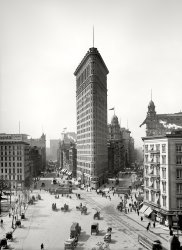
- Miami Beach: 1941
- March 5, 1941. "Raleigh Hotel. Collins Avenue, Miami Beach. Pool, to ocean from balcony. L. Murray ... Not Yet Solo's assertion that the patrons of this hotel could watch blazing cargo vessels from the comfort of the pool before the ... Posted by Dave - 01/31/2013 - 1:47pm -
![Miami Beach: 1941 March 5, 1941. "Raleigh Hotel. Collins Avenue, Miami Beach. Pool, to ocean from balcony. L. Murray Dixon architect." Rustling those palm fronds, the winds of war. Large-format acetate negative by Gottscho-Schleisner. View full size.
Only the time line was wrongSolo was right about the ships occasionally being torpedoed off shore -- but only after the war had started. I know: I lived in Fort Lauderdale at the time. Ships heading North would use the Gulf Stream to help them along, so the Krauts knew where they would be. Beaches were patrolled and watch towers were built beachside to track aircraft. Nervous time for all.
Still therehttp://www.raleighhotel.com/explore/the_pool/
Looks very much the same, today! From Bing Aerial View: http://binged.it/WDClE7
Ringside Seats for the Slightly SurrealThough the US was still months from having an active role in WWII when this photo was taken, one could have grabbed a parasol-festooned fruity libation of an evening and watched blazing cargo vessels sinking just a few miles off the beach as German U-boats plied their trade against British shipping.
Actually Not YetSolo's assertion that the patrons of this hotel could watch blazing cargo vessels from the comfort of the pool before the US entry into the war is wrong. For one thing most of the ships carrying cargo and oil from the Gulf ports were American and would join up with the Anglo-Canadian convoys at Halifax or Sydney. Both Hitler and Admiral Donitz who commanded the U-Boat fleet believed that US intervention in World War I had led to the failure of the German submarine blockade of Britain during World War I. They were anxious to keep from provocative incidents that would bring the US into the war, although with US ships convoying merchant vessels in the North Atlantic sometimes made that difficult.
Wide Leg PantsComing of age in the late 90s, there was a ridiculous fad of outlandishly wide-legged jeans, for girls in particular. I didn't realize that the predecessor to that fad could be found with our grandparents (or at least with that woman in the center foreground.)
[Very popular at the time. - tterrace]
(The Gallery, Gottscho-Schleisner, Miami, Swimming)](https://www.shorpy.com/files/images/SHORPY_5a06571u.thumbnail.jpg)
- When Hustle Met Bustle: 1919
- ... Aloft division of Starwood Hotels to operate the 136-room hotel. The hotel would occupy the floors two through nine of the building with 108 ... Posted by Dave - 07/24/2012 - 9:57pm -
![When Hustle Met Bustle: 1919 Detroit circa 1919. "View of Woodward Avenue and Washington Boulevard; Whitney Building and Grand Circus Park." Also one of the "Winged Victory" statues seen earlier here. 8x10 inch glass negative. View full size.
Whitney ReduxThe 19 story David Whitney building in the center of the photo, abandoned in the '80s, got some good news recently:
In December 2011, plans moved another step when (Whitney Partners) announced it signed an agreement with the Aloft division of Starwood Hotels to operate the 136-room hotel. The hotel would occupy the floors two through nine of the building with 108 condominium units on floors ten and above to open in 2014.
http://en.wikipedia.org/wiki/David_Whitney_Building
http://detroit1701.org/WhitneyBldg.htm
Is that a street performer posing as a statue?I've seen them in Italy a number of times.
He should have called it Andrew'sI agree with Mark P's comment.
From the 1919 Detroit City Directory:
Hair'sNot a great name for an eating establishment.
Still in Business2nd sign on the left side of the Whitney is Dittrich Furs. They are still in business with TV ads and a website. Currently located on 3rd St North of Grand. Nice to see some longevity.
Roy's Wife's UncleNice shot of Hudson's Dept Store.
Roy Chapin Sr. was married to Joseph Hudson's niece. Chapin was one of the founders of the Hudson Motor Car Co., named after his benefactor - Mr. Hudson, founder and owner of the Dept. store.
That Street Performer...appears to be a "Winged Victory" enroute to some statehouse dome.
[I thought the reference was to this. - tterrace]
(The Gallery, Cars, Trucks, Buses, Detroit Photos, Streetcars)](https://www.shorpy.com/files/images/SHORPY_4a25752a.thumbnail.jpg)
- This Way to Kloskys: 1910
- ... the bunting and the partially legible sign on the Windsor Hotel on the right side of the photo. The 20th Reunion and Meeting of the ... Posted by Dave - 08/21/2012 - 6:30pm -
![This Way to Kloskys: 1910 Mobile, Alabama, circa 1910. "Royal Street looking north." Points of interest include a lineman up a pole and the fickle finger of retail. View full size.
For All the Hustle and Bustleit's interesting how many men seem to be in no particular hurry. On the left two are looking up the street, maybe at the approaching motor car. Two are hanging on the corner. And across the street, two guys gabbing on the sidewalk, and five more doing the same in the intersection. The era? The South? Both?
The woman with the 12 pound hatIs she waiting for the light to change before crossing? it may be a while until crossing lights are invented. Or is she afraid of the mob of males across the street.
The fella on the pole betterThe fella on the pole better watch out on the way down, that cable is in a bad place!
A Question Of GrammarShouldn't the plural of Klosky be Kloskies, or is to really Klosky's?
[Klosky's is possessive, not plural. "Is to"? -Dave]
My question really became scrambled when I mistyped "to" instead of "it."
But you got me again, fair and square, Dave.
I do agree, Klosky's is possessive.
(I've given myself a headache.)
The pole climberprobably left his hardhat downstairs at AHC for cleaning--or a 5¢ shine.
The lady below him has better head protection.
LetterboxedThere are mailboxes on both side of the street. Today you are lucky to find a mailbox anywhere near where you are.
The lone woman?I can only see one female in this photo. Not counting if the horse is a mare. And she looks like she could kick most of these guys across the street if she wanted to.
I spot at least two, perhapsI spot at least two, perhaps three women: two on the left under the hat cleaning sign; and one in the distance crossing the road ahead of a buggy (in a white skirt and holding her hat, maybe).
UCV 20th Reunion and MeetingTowards the end of April 1910, perhaps, considering the bunting and the partially legible sign on the Windsor Hotel on the right side of the photo. The 20th Reunion and Meeting of the United Confederate Veterans was held in Mobile from April 26-28, 1910. The Jones M. Withers Camp of the UCV was located in Mobile. That would fit the sign, the visible part of which identifies it as the Headquarters of "-ther's Camp" (setting aside an error in the placement of the apostrophe).
Rooftop Tower MysteryI"m curious about the tower structure on top of the building in the distant center. Can't be radio, not in 1910. Any ideas?
[There were lots of radio masts in 1910, especially in coastal cities. Wireless telegraphy was widely used in shipping. - Dave]
(The Gallery, DPC, Mobile, Stores & Markets, Streetcars)](https://www.shorpy.com/files/images/SHORPY_4a23636a.thumbnail.jpg)
- Well-Connected: 1955
- ... can see a couple of these switchboards in the lobby of the Hotel Congress in Tucson, AZ. They were removed from the Pioneer Hotel c.1974. (One of them lived in my dining room for 10 years!)
Congress ... Posted by Dave - 08/09/2015 - 10:27am -
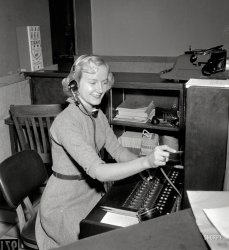
- The Help Desk: 1864
- ... men looked up the word "ramada" and found out it wasn't a hotel chain.
(The Gallery, Civil War) ... Posted by Dave - 08/31/2021 - 12:51pm -
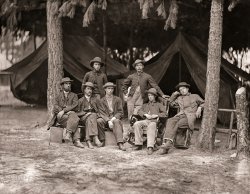
- Inaugural Ball: 1925
- ... out By the time this photo was taken (at the Mayflower Hotel), the only truly new guy -- Vice President Charles W. Dawes -- had ... walls is beautiful and the balconies are wonderful. The hotel itself is interesting; hallways are almost like a maze amking it hard to ... Posted by Dave - 09/12/2011 - 12:42pm -
![Inaugural Ball: 1925 "Inaugural Ball. March 4, 1925." And Calvin Coolidge could have danced all night. National Photo Company Collection glass negative. View full size.
Balled outBy the time this photo was taken (at the Mayflower Hotel), the only truly new guy -- Vice President Charles W. Dawes -- had already worn out his welcome. As soon as he was sworn into office (in the Senate chambers) he read the senators the riot act about all of their traditions he thought they needed to abandon, while delaying the main event - his boss Calvin's inauguration. From that point forward, Coolidge would have little use for him.
The roomThis is an interesting space: not really huge, almost intimate. The balconies fit right into the overall scale of the room. I just wish it had been a "faster" film so we could see the attendees better.
Re: The RoomThis is an amazing photo -- a surreal phantasmagoria. Like a dream. Or a Fellini movie. If everything was frozen sharp it wouldn't be that way.
[For some reason I keep expecting to see Jack Nicholson staring back at us. - Dave]
The Mayflower Ballroom Although I'm sure it was in full swing last night, the ballroom looks more staid for meetings these days:
Singing in the Rain"I make more money than Calvin Coolidge . . . put together!"
The roomI have been to an event in this room, it is bigger than you think. We had about 55 in our group and the room seemed cavernous. The artwork on the ceiling and walls is beautiful and the balconies are wonderful. The hotel itself is interesting; hallways are almost like a maze amking it hard to find your room. I wonder if some of the attendees got *lost* finding their room after the festivities...
(The Gallery, D.C., Natl Photo, Politics)](https://www.shorpy.com/files/images/13115u_0.thumbnail.jpg)
- Grand Union: 1912
- New York circa 1912. "Grand Union Hotel, 42nd Street and Park Avenue." 8x10 inch dry plate glass negative, ... of the square is Grand Central Station. Grand Union Hotel was closed in 1914 and the building demolished in 1916. It's said no key could be found to lock the front doors when the hotel closed, nobody recalling that one had ever been made. The Pershing ... Posted by Dave - 06/09/2015 - 12:10pm -
![Grand Union: 1912 New York circa 1912. "Grand Union Hotel, 42nd Street and Park Avenue." 8x10 inch dry plate glass negative, Detroit Publishing Company. View full size.
No overheadI noticed there are no overhead wires and the track has an off-center third rail or slot. Were these cable cars, or was an electrical feed below ground and accessed through the slot?
[The latter. -tterrace]
Half a Grand UnionIn streetcar parlance a Grand Union is a track arrangement allowing each approaching car to cross straight through the intersection or to turn left or right onto the perpendicular street. This intersection may indeed qualify but, unfortunately, we can only see half the area.
Now Pershing SquareThis area is now known as Pershing Square, although eventual General of the Armies John J. "Black Jack" Pershing was only a Brigadier General in 1912. The most famous occupant of the square is Grand Central Station. Grand Union Hotel was closed in 1914 and the building demolished in 1916. It's said no key could be found to lock the front doors when the hotel closed, nobody recalling that one had ever been made. The Pershing Square Building was built on the spot and completed in 1920. It survives.
[Ahem; Grand Central Terminal. -tterrace]
ChauffeurI'm intrigued by the luxury landaulet in the center of the photo with the driver in the timeless repose of a waiting chauffeur. I can barely make out the shape of the radiator, Winton? Ford Model K? --any guesses?
Great photo----
(The Gallery, Cars, Trucks, Buses, DPC, NYC, Streetcars)](https://www.shorpy.com/files/images/SHORPY-4a23879a.thumbnail.jpg)
- West Market Street: 1907
- ... seals it for me, thanks Revelator.
I'm glad there's a Hotel English for me to stay at as my American ain't too flash.
That's ... Posted by Dave - 08/21/2012 - 11:19am -
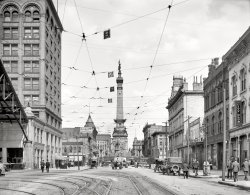
- Twin Falls II: 1941
- ... Avenue East and Hansen The air-conditioned Rogerson Hotel on our left was at the north corner of Main Avenue East and Hansen Street ... have generally lost their upper stories. The Rogerson Hotel building is visible at left; its top story went after a 1935 fire. The ... Posted by Dave - 09/23/2018 - 10:57am -
![Twin Falls II: 1941 From start to finish, a life on wheels.
May 1941. "Main street of Twin Falls, Idaho. According to Idaho State Guide (Federal Writers Project), this town has the distinction, unusual in towns in the section, of being planned." Photo by Russell Lee for the FSA. View full size.
Corner of Main Avenue East and HansenThe air-conditioned Rogerson Hotel on our left was at the north corner of Main Avenue East and Hansen Street East, so this view has us looking southeast.
+75 Much lower and much leafierMain Avenue East has received a good deal of urban forest plantings in the last three-quarters of a century, while the taller buildings have generally lost their upper stories. The Rogerson Hotel building is visible at left; its top story went after a 1935 fire. The entire building was demolished as too far gone to save in 2016, one year after this Google cap.
The Golden Rule in the next block is now a furniture store, and many of the buildings we see have fallen victim to cases of "façade modernization" disease, when they haven't fallen altogether.
[Dear people: Please learn how to embed a google Street View before posting. I'm tired of doing it for you. - Dave]
Dave, the instructions said "links will be converted" and I trusted that. Bad link removed.
How to include Google Street View in a commentDave, it must be frustrating to keep telling people how to include Street View URL links in comments. You did so for me some time ago and I thank you. But the latest time I included such a URL it was just random luck the URL worked. I'd forgotten the trick and had no way to find it.
Perhaps the working trick of referencing Street View could be put at the top of the Comment Guidelines? Or even added as an item in the comment entry form? "Paste a street view URL link"?
[There is no "trick." Simply apply eyeballs and brain to what's in front of your nose. And of course you could always google it! - Dave]
Easier, but ....This angled parking layout was very popular in the Midwest of my youth, though backing out safely often depended on the restraint of one's fellow motorists as well as one's own lumbar flexibility.
Unfortunately, becoming accustomed to "nose-in" parking while learning to drive often had a deleterious effect on one's ability to parallel park for the driver's license test!
Right over thereHe said he'd leave the package in a gray Plymouth, or was it a Dodge?
And NowThe view is Main Street at Hansen, looking southeast. The remains of the air-conditioned Rogerson Hotel are at the left, the building with the ugly (aluminum?) siding. It was torn down after this Street View was taken in 2012.
(The Gallery, Cars, Trucks, Buses, Russell Lee, Stores & Markets)](https://www.shorpy.com/files/images/SHORPY-8c01109a.thumbnail.jpg)
- Open Carry: 1929
- ... the foundation of the spring house is still there, but the hotel burned down in 1934.
1930s Hipsters I think we're seeing 1930s ... Posted by Vintagetvs - 01/23/2016 - 9:54am -
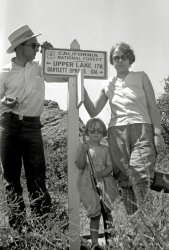
- To Mars in the Air Ship: 1905
- ... to the to the left [not seen] and the Metropolitan Hotel on the right).
Then again in 1927.
That fellow on the left, It ... Posted by Dave - 01/23/2022 - 1:33pm -
![To Mars in the Air Ship: 1905 Circa 1905. "Along the boulevard -- Revere Beach, Massachusetts." All aboard for the Red Planet! 8x10 inch dry plate glass negative, Detroit Publishing Company. View full size.
A little traveling music professor, if you pleaseHaven't made a comment on Shorpy for a very long time but this photo hit me with the time travel blues. Wouldn't it be great to travel back to 1905, walk along looking in the shops, checking out what the people were wearing, listen in to their conversations to see what the talk of the day was, and best of all - strike up a few conversations to hear their opinions on whatever subject they chose. It would be fascinating. Thanks to Dave and his Shorpy, a journey of the mind is a welcome trip.
More Evidence I'll take your word on the shirt collar but is he using (or trying) to use his phone? Possibly not time travelling rather a glitch in the Matrix. He may have been gone a picosecond later.
Fun & FrolicMeanwhile, in "The Pit" --
Slide, Chutes, Whirl-a-Gig, Barrel of Fun, Crazy Stairs, the Twirler, Shaker and Trick Steps.
A man from another eraThis man doesn't look dressed like those of his time. He does not have a hat, he has a shirt with rolled up sleeves, tight pants and neatly combed back hair. He looks more like a man from the 1950s. Really unbelievable.
[A 1905 shirt collar, though. - Dave]
Still thereThis picture was taken probably within minutes of Rough Riders: 1905, just below this post. The same boy is sitting in the same place, to the far right, on the wall by the pavilions with his back to Broad Sound and his front to the idle pursuit of people-watching. Looks to have been an uncomfortably hot day; he was probably trying to decide between a Lemonade "To Order" and a soda fountain Coca-Cola, from Trask's. Both a bargain at five cents.
Beach bonfire in waitingBurned. (Of course !!)
Multiple times:
First in 1918 (taking out some structures to the to the left [not seen] and the Metropolitan Hotel on the right).
Then again in 1927.
That fellow on the left, It seems that it was his casual Friday. Very daring for him not to wear a full woolen suit with a hat on a hot, humid, sunny summer day. I dig his style.
By threesI think our dear editors at Shorpy are feeling antsy for warmer days. But hey, soon it will be March, and the winds will blow in warmer. But thank you for this trifecta of Revere Beach. I too would like to step into a booth or through some "gate" and find myself there -- a warm summer day, sitting along the wall and just absorbing everyday life in 1905. I'd have to dress the part to not draw attention. I'd rummage through the attic to see what I can find. Just for an hour to start, lest I be arrested for vagrancy.
To Mars in an AirshipIn 1905 Billy Murray's great song was released. I wonder if they were dancing to that tune in the Nautical Gardens.
https://www.youtube.com/watch?v=gxoZrqnkElU
(The Gallery, DPC, Swimming)](https://www.shorpy.com/files/images/SHORPY-4a12858a.thumbnail.jpg)
- Bancroft House: 1907
- Saginaw, Mich., circa 1907. "Bancroft House Hotel." Note the transit schedule on the corner, "Interurban cars for Bay ... light was Washington and Genesee, outside the Bancroft Hotel. It was suspended from a rope and people came from miles and miles away ... Posted by Dave - 08/25/2011 - 5:08pm -
![Bancroft House: 1907 Saginaw, Mich., circa 1907. "Bancroft House Hotel." Note the transit schedule on the corner, "Interurban cars for Bay City." Detroit Publishing Co. View full size.
InterestingDepth of field.
Relief CrewsBelow the interurban schedule sign are at least three interurban or street railway crewmen in their uniforms most likely waiting to make a "crew change" on the next car or cars through. This is still a common practice in mass transit today. The little building next to the line pole might be a phone booth or a shelter for the starter, inspector or supervisor who would keep track of the streetcars and interurban cars schedules assuring that they would be on time. Some contemporary larger transit systems use CAD (computer aided dispatching) and GPS to do this today.
Two interesting facts1. The first street corner in the world to have electric light was Washington and Genesee, outside the Bancroft Hotel. It was suspended from a rope and people came from miles and miles away to see it.
2. First incandescent bulb in Michigan lit the Bancroft Hotel. [Link]
New lifeThe Bancroft is getting a new life after being vacant for years. There is a restaurant in the floor and refurbished apartments throughout.
(The Gallery, DPC, Streetcars)](https://www.shorpy.com/files/images/4a22426a.thumbnail.jpg)
- Civil War Veterans: 1913
- ... battle on display. You also have Hersheypark, the Hershey Hotel, and the Amish in the Lancaster area. Great place to visit.
50 years ... Posted by Dave - 11/11/2014 - 1:07pm -
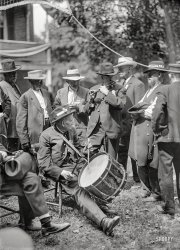
- Everywhere a Sign: 1912
- ... feet, on the roof of the Kohn Building, just south of the Hotel Knickerbocker, caught one of the worst puffs of the big wind and toppled ... by a YMI clothing store. However, the famous Knickerbocker Hotel building to the left is still going strong. But serving as an office ... Posted by Dave - 09/12/2011 - 2:26pm -
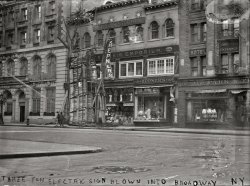
- Savannah: 1905
- ... It's likely this picture was taken from the De Soto Hotel that used to stand on this corner. That old building was Romanesque ... Posted by Dave - 07/22/2012 - 2:45pm -
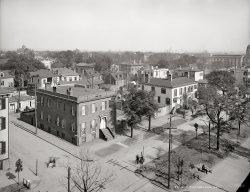
- The Mode: 1919
- ... Neddo, president of United Cafeteria Company and owner of Hotel Neddo, of Norfolk Va., is accorded the praise for the enterprise that ... Posted by Dave - 09/12/2011 - 11:21am -
![The Mode: 1919 Circa 1919, another Washington streetscape. "The Mode, 11th and F Streets." National Photo Company Collection glass negative. View full size.
Oh, that reminds me...I gotta pick up a couple of hat frames tomorrow.
Do you suppose ...that some of the ghosts in this picture would have been virtually invisible if they hadn't chosen to wear shoes that day?
Hatter and haberdasherNow what is the difference between a hatter and a haberdasher? I had always assumed they were the same.
[Hatters and milliners do hats; haberdashers do haberdashery -- men's clothing and accessories. - Dave]
Baked Possum TodayThe United Cafeteria opened in February 1919. The ad below is for one of their more exotic dinners. Based on other advertisements, the more typical fare included Roast Prime Ribs, Oyster Pot Pie, Chicken A La King, and Lobster a La Neuburg.
A Success From the Start
Washington during the past week has given cordial welcome to the United Cafeteria, 1008-1010 F street, opened a few days ago as the latest addition to the National Capital's already noteworthy assemblage of dining places. The new restaurant is unique in many of its features. A woman chef superintends the appetizing conceits that proceed from the kitchens to the display counters, patrons are taken care of at double capacity service stations and a stringed orchestra is regularly in attendance. A palm room is the novelty that occupies the basement floor.
Every appointment of the spacious dining rooms, from the immaculate linen to the generously filled platters, is suggestive of the refinements of service not ordinarily afforded by dining places of the popular, quick-lunch type. Courtesy, promptness and thoroughness of service, together with every excellence of cuisine, have united to command a patronage of over a thousand patrons at every meal. To Richard Neddo, president of United Cafeteria Company and owner of Hotel Neddo, of Norfolk Va., is accorded the praise for the enterprise that gives Washington this new and commodious and altogether desirable place to eat. It's the crowning achievement, by the way, in the career of a man who as a train boy received his first "service" lessons in dispensing water to travelers on the old C.H. and D.R.R [Cincinnati, Hamilton, & Dayton Railroad] back in 1873.
Washington Post, Feb 9, 1919
Boccioni Anyone?Look at the couple crossing the street and behold the vision that inspired the Futurist movement.
Still thereThe Mode is gone, but not the two fine red brick buildings behind it on 11th.
View Larger Map
Even back then...you couldn't find a parking space in D.C.
Possum PieI've heard possums described in many different ways, but "the sweetest morsel that can be set before man" is not one of them. I wonder how many hungry customers showed up that day?
Nice ridesA couple of expensive cars here -- can't identify the town car in the center, but the one with the light colored wheels to the left is a Pierce-Arrow.
Scarred and batteredThis building was sadly maimed before it was razed in the mid-90s - it's visible at far left here:
image from Flickr user Kinorama.
+90Below is the identical perspective taken in September of 2009. The Mode building was a pretty pathetic site in its last years on that corner.
(The Gallery, Cars, Trucks, Buses, D.C., Natl Photo, Stores & Markets)](https://www.shorpy.com/files/images/30396u.thumbnail.jpg)
- Pain's Spectacle: 1905
- Brooklyn circa 1905. "Oriental Hotel and bath house, Manhattan Beach, N.Y." At left, a sign pointing the way ...
Our photographer stands with the Brighton Beach Hotel right behind him. The Manhattan Beach Baths to the right, and the background is the Oriental Hotel.
I don't believe I've ever seen a photo of the Manhattan Beach Baths ... Posted by Dave - 04/09/2016 - 5:55pm -
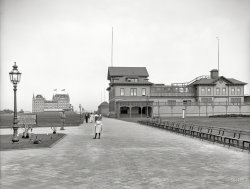
- Cafe Ginza: 1941
- ... right (it's long gone, of course, along with the Bo-Chow Hotel and the Eagle Bakery & Restaurant - this document shows how the ... Posted by Dave - 12/07/2012 - 3:19pm -
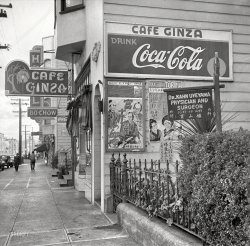
- Cadillac Square: 1902
- ... old hotels, the Russell House, first opened in 1857. The hotel has since been replaced with two successive buildings, each bigger than the last. First came the Hotel Pontchartrain (a great favorite of both the Detroit Publishing Co. and ... Posted by Dave - 02/13/2013 - 12:14pm -
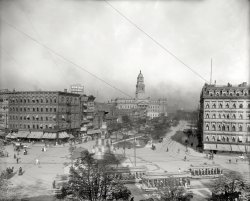
- Guggenheim Going Up: 1957
- ... Tafel called Cohen and told him to run down to the Plaza Hotel right away. When he got there, Wright opened the door to his suite in his ... Posted by Dave - 04/04/2013 - 1:44pm -
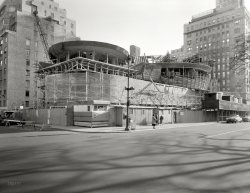
- Joe's Jungle Bungalow: 1904
- ... a solid demand for thatched roofs down here. Every beach hotel with a tiki bar has one, in addition to many inland hotels striving for ... Posted by Dave - 08/25/2012 - 4:56pm -
![Joe's Jungle Bungalow: 1904 Palm Beach, Florida, circa 1904. "Alligator Joe's bungalow in the jungle." 8x10 inch dry plate glass negative, Detroit Publishing Company. View full size.
Jungle CapitalismOne thing that can be said about Joe, he has the entrepreneurial spirit. He knew how to market his alligators and his residence.
Here's the great man himself!Alligator Joe poses at entrance to main pavilion. http://royalpoincianahotel.blogspot.com/
Out of the movies?This looks like Tarzan or Dr. Livingston should live here!
Thatch MastersThere is still a solid demand for thatched roofs down here. Every beach hotel with a tiki bar has one, in addition to many inland hotels striving for that "beach" ambiance. The Seminoles build the best ones.They also run a pretty mean casino.
I wonderif anyone called it Alligator Joe's Bungalow in the Jungle-O.
I know I would have.
Soft drinks, cigars, peanuts and piesWhat else would you need, except of course a baby carriage and a duck?
[I think that's more of a grownup carriage. And a rooster. - Dave]
Before televisionThis is what Captain Kangaroo might be up to.
A Rooster?That rooster sure looks to me like it has a bill and webbed feet.
[We'll put someone else in charge of the chicken house. - Dave]
Rolling ChairThat's a "rolling chair" along the lines of the ones seen in the Atlantic City photos.
[Below: At the Royal Poinciana in Palm Beach, home of the bicycle chair. - Dave]
(The Gallery, DPC, Florida)](https://www.shorpy.com/files/images/4a11871a.thumbnail.jpg)
- Bisbee, Az.: 1940
- ... as you're facing it is the relatively posh Copper Queen Hotel - a 4-story affair that holds the distinction of being the longest continually operating hotel in the state of Arizona (opened 1902).
Back-Alley Ablutions Subway ... Posted by Dave - 08/08/2018 - 1:54pm -
![Bisbee, Az.: 1940 May 1940. "Side street [Subway Street] of Bisbee, Arizona. Copper mining center." Photo by Russell Lee for the Farm Security Administration. View full size.
Updated streetlightThe incandescent streetlight was undoubtedly converted from an arc light, which had to be maintained several times a week.
Zephyr!Holy Moly, a 1939 Lincoln Zephyr Coupe parked in front of the jewelers sign. Flathead V12 power!
Likely very old train tracksI think those tracks are from the original El Paso & SouthWestern (EPSW) rail to Bisbee. The trolley tracks ran along Main Street.
[The EPSW line would not have gone through the business district. Bisbee was served by both a streetcar system, with much trackage re-laid and embedded in concrete in 1920, and the Warren-Bisbee Railway, an interurban trolley with service to the nearby town of Warren. - Dave]
Now (2016) with Air Conditioning
66 years of public service . . . make 100 cigarettesI was intrigued by what was visible on a distant building, and quickly found the full text of the Bull Durham roll-your-own pitch. They seem to have been counting years starting from around 1860, which means the sign had been there a while when Lee took this photo.
Near 8 Subway StFrom research with Bing Maps, I was surmise we are near 8 Subway Street.
It's amazing how many structures are recognizable today. For example, the corner curb steps on the sidewalk are still there.
One interesting detail that seems to be gone is the abandoned RR siding track buried in the street. It would be interesting to know which building(s) had rail service, and why.
Also absent is the quaint streetlight mounted on a pulley-and-rope system so that it can be lowered to change the bulb.
So that's what that area was for!I just knew it as an unusually wide alleyway behind Main Street, which is well out of frame to the left.
The first storefront on the right beyond the telephone pole now houses (or did in May 2013, when I was there) a little vintage kids toys/antique shop -- picked up a pretty fair stack of western swing 78's there, too.
To the left, the L.L. Gilman Jeweler's building now houses a gigantic antique shop. 3 floors (including basement) packed to the gills with just about any vintage knick knack you'd want if you've got the money. Place still has an intact vault where they keep all the records (yes, I'm a 78rpm record collector).
Also, about 200 feet behind and around 50 feet up a set of steps to the left as you're facing it is the relatively posh Copper Queen Hotel - a 4-story affair that holds the distinction of being the longest continually operating hotel in the state of Arizona (opened 1902).
Back-Alley AblutionsSubway Street's namesake is the Subway, a large subterranean drainage channel paralleling Main Street. After a series of devastating floods, Bisbee thoroughfares including Subway and Main were reconfigured and paved with concrete to serve as spillways during the monsoon season:
Ghost SignIf you go backwards a little on the Google Street View (click the arrow pointing towards you), you can still see white painted lettering above the Bisbee Antiques sign on the brick building towards the left. I believe I can make out the "Gilman" and "Jeweler" shown in the 1940 photo. In fact, the darker brick color seems to appear only where the original painted sign once was.
38 Zephyr I believe the Zephyr is a 1938. The trunk handle is above the license plate. I'm probably wrong, but that's what it looks like.
(The Gallery, Mining, Russell Lee, Small Towns, Stores & Markets)](https://www.shorpy.com/files/images/SHORPY-8b24907a1_Bisbee.thumbnail.jpg)
- Million Dollar Highway: 1940
- ... towns along the way. Especially Animas Forks. The Western Hotel in Ouray is a good place to stay. Or the Beaumont if you want fancy. - ... Posted by Dave - 04/23/2008 - 9:39am -
![Million Dollar Highway: 1940 October 1940. "Million Dollar Highway is cut through massive rocks in Ouray County, Colorado." U.S. 550 between Silverton and Ouray. Now a paved modern highway, this is a spectacular mountain route that I've driven many times over the years. View full size. 35mm Kodachrome transparency by Russell Lee.
Ouray ActivitiesThe creek you see at the bottom of the photo flows into Ouray and is diverted through perforated pipes set along the canyon rim in the winter. The sheets of ice formed by the water trickling over the rocks create a perfect ice climbing venue, with competitions every January and February. The creek flows into the Uncompaghre River (Native American name meaning "no cell service"). The hot springs in town are a great way to take the chill off your bones after a day on the ice.
[My favorite summer activity: Jeeping the Alpine Loop and exploring the ghost towns along the way. Especially Animas Forks. The Western Hotel in Ouray is a good place to stay. Or the Beaumont if you want fancy. - Dave]
Red Mountain Pass If I am not mistaken this section of road climbs over Red Mountain Pass.
A few years back I rode my bicycle over this pass, with 750 other riders,on the way to Durango. While it is now a "modern paved highway" it still has no guardrails as they would be an impairment to clearing the many feet of snow they get each year. The drop off right next to the edge of the road(first on the right side then the left) made some want to hug the center line, but the car traffic was not conducive to this.
The night before we left for the ride a shop owner in Ouray gave bikers this advice. "For the first 12 miles lean left. For the next 12 miles lean right."
Bus ride anyone?This is truly one of the greatest last frontier drives ever. We used to drive up from New Mexico to play basketball with Ouray and Silverton. This road made bus trips very interesting. Great photo.
HistoryThe Million Dollar Highway got its start in the 1880s as a 12-mile toll road between Ironton and Ouray, a remarkable feat considering it was before the age of the internal combustion engine and done by men with picks and shovels, working in snow and very low temperatures. Drive thru in the winter to appreciate. I've jeeped this area extensively... see pics at
www.fotki.com/tbill and
www.fotki.com/tbilmelms
550I remember riding over this highway during WW2 when I was a very small child. It wasn't paved yet and was just barely passable for two vehicles going in opposite directions. The driver always had to honk when approaching a blind curve, and the car on the outside had to move over and stop for the inside vehicle. I was terrified and spent much of the trip huddled down in the back seat with my eyes closed.
We lived in Pagosa Springs at the time, and I am a Colorado native, so mountain roads were nothing new to me. But this one was the worst. I was between 3 and 4 at the time.
Eek!I have driven this during the summer and even then I wanted to hug the centerline. I can't imagine driving this during the winter.
Golden RuleWhen I was a kid in the 40's, we were taught that the name for the Million Dollar Highway comes from the value of the ore-bearing fill that was used to construct it. As kids, we would gather mill tailings from the road sides in the mountains and take them home to extract gold by crushing and panning. We would alway get a few flakes of gold. I'm sure that there are few or none of these piles of tailings left because the price of gold now makes it profitable to use the very low grade ore.
(The Gallery, On the Road, Russell Lee)](https://www.shorpy.com/files/images/1a34174u.thumbnail.jpg)
- Open Floorplan: 1938
- ... that borrows on the grandeur of the Knickerbocker Hotel.
The mansion went through many hands in its last years, each new ... Posted by Dave - 08/03/2012 - 4:05pm -
![Open Floorplan: 1938 1938. Iberville Parish, Louisiana. "Belle Grove." The rear of the mansion. 8x10 inch safety negative by Frances Benjamin Johnston. View full size.
Sic Gloria MundiDecay caught mid-stride. This photo was taken about 10 [actually more like 20] years after Belle Grove had been abandoned. About ten years down the road [14 years -- 1952], what was left of the carcass caught fire and was leveled.
The house was built in three wings. The man is standing in the central hall of the main wing, the front door can be seen in yesterday's photo. The door to his left and gallery of windows are the remains of the dining room. The fallen catwalk was originally a balcony facing the sugar fields that made up the plantation. No doubt this is where the owners took guests to show off their property, real and "personal".
The wing to the right held the kitchen and domestic slaves' quarters, while the arches below gave access to the carriage houses, jail, and storage. There is no basement: the house is yards from the Mississippi River and the water table is too high.
The third wing had collapsed some years earlier and was positioned in the foreground. Had it survived, the man would be at the foot of a vast, circular staircase to his right. The treads are gone, but diagonal bands of plaster can still be seen. The wing also held guest rooms and the library. The bricks have long disappeared to scavengers.
Contrary to rumor, there was no ballroom in the attic. It's just a confabulation that borrows on the grandeur of the Knickerbocker Hotel.
The mansion went through many hands in its last years, each new owner vowing to restore it. I suspect the house could not be saved. It's well photographed, and even the first generation of post-abandonment pictures show cracks in walls that are well out of plumb: the muddy land just slipped out from under the foundations and the rest was inevitable.
Belle GroveThanks for the new visits to our site!
Jason
http://bellegrove.net
So quickly to ruinHow odd that such a magnificent structure didn't even last 100 years. There are stone and brick buildings all over the world that are hundreds, even thousands, of years old and in better shape than this. I'd complain to the general contractor for sure, I think he cheaped it out with the masonry subs.
How beautiful it must have been!I grew up in a wonderful antebellum home (c. 1840) in Mississippi. It certainly didn't have 75 rooms (about one-third that). The large windows were to allow cooling breezes to come in off the river, as the heat could be unbearable. The high ceilings help to concentrate the hot air near the top, and the house was elevated off the bottomland to help shield the residents from the "unhealthy vapors." Thankfully, we had the luxury of window air conditioners! My old home was sold years ago, but it has been kept in fine repair and dazzles on Pilgrimage tours today. (I sure with I had that house today!) So sad Belle Grove died a tragic death. Kind of makes you wonder what went on there.
Belle Grove's DemiseAlthough vandals and scavengers did their destructive worst to Belle Grove, it is generally believed that her demise came about due to her roof. Over the years after her abandonment, her roof was not maintained, which allowed rainwater to seep into her attic. The water continued downward, dissolving plaster and rotting wood. As vandals broke windows and smashed doors and shutters, more rainwater entered. Had the roof been maintained, and the windows and doors boarded up, less destruction would have occurred. At that point, Belle Grove's new owners could have put their full attention toward shoring up the foundation, which - through fraught with problems - could have been fixed.
I can fix this.All I need is duct tape, super glue, a multi tool, and two weeks, tops!
Not the builder's faultI read a little last night about Belle Glade Grove, and the damage seen here was mostly caused by scavengers looting for woodwork, fittings, used bricks, etc. They brought down that wall, and the weather finished the damage. The building was left vacant for years.
DeteriorationLouisiana is a harsh environment - the constant humidity isn't just present in the warm seasons, but also during the winter. Hard freezes followed by quick thaws and long scorching summers wear out even the strongest structures quickly. Building foundations also tend to shift and buckle, since there's not much - if any - bedrock under the southern half of the state.
(The Gallery, F.B. Johnston)](https://www.shorpy.com/files/images/01390u1.thumbnail.jpg)
- Birthplace of Old Glory: 1900
- ... But Darragh's house on Second Street was replaced by a hotel, so that left Ross. A campaign to save her house hustled pennies from the ... Posted by Dave - 05/28/2013 - 10:49am -
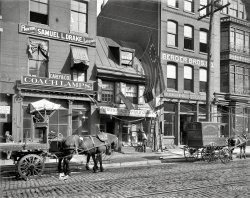
- Atlantic Avenue: 1905
- ... But ended up losing them to some rich guy with a hotel on Boardwalk.
(The Gallery, Atlantic City, DPC, Streetcars) ... Posted by Dave - 08/20/2012 - 9:52am -
![Atlantic Avenue: 1905 Atlantic City, New Jersey, circa 1905. "Atlantic Avenue." Meet you in front of Two Stumps in an hour. Detroit Publishing Co. glass negative. View full size.
Detroit Publishing Co.I was wondering, was the DPC cmomissioned to take photos all over the USA, or did they do this on their own. Interesting picture of Atlantic Avenue.
[Detroit Publishing's main business was selling color postcards printed using autochrom process. These glass negatives were the starting point. And right here on Shorpy, 100 years later, is where they are being seen for the first time in all their hyper-detailed glory. - Dave]
Two Stumps?Then you really don't need shoes at all.
After 105 years, not much is leftThis appears to be the corner of Pennsylvania and Atlantic Avenues. The old Courthouse can be seen on the left, and is now gone, as is almost everything else. The only structure extant is the six-story building with the clock-cupola on the right. The clock and cupola are gone, but the distinctive front entrance is intact.
View Larger Map
What is this, the Old West?Come on New Jersey, it's the 20th Century. Put down some asphalt, cobblestones, anything!
[The paving here seems to be brick, with an overlay of crud and mud. - Dave]
Coffin nails...I note that Smoker's Paradise is right across the street from the undertaker's.
Amazing detailThe building on the right has a lot of interesting details on it, like the rounded windows (they must have been expensive to replace), the fleur-de-lis below the windows, and the old men (Neptune?) along the roof line.
I also liked the Common Sense Shoe Store, which must have been for people without stumps.
Help WantedThey talk about the "good old days" being a misconception. Still, when the Employment Bureau has a "help wanted" sign out front, makes you think certain things like the job market were certainly better in 1905.
Used to own two houses on Atlantic Avenue.But ended up losing them to some rich guy with a hotel on Boardwalk.
(The Gallery, Atlantic City, DPC, Streetcars)](https://www.shorpy.com/files/images/4a11557a.thumbnail.jpg)
- Netherland and Savoy: 1905
- ... one month's rent in 2011.
58th Street Once More The Hotel Savoy Plaza has been replaced by the General Motors Building where, in a ... Apartment House The building shown to the right of the Hotel Savoy is the Bolkenhayn Apartment House, situated at the corner of Fifth ... Posted by Dave - 08/01/2012 - 5:45pm -
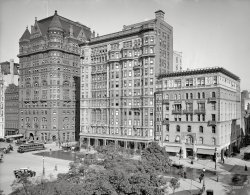
- College Ices: 1908
- ... it met a premature end. Built in 1857 as the city's first hotel, and standing at the northwest corner of Asylum* and Trumbull streets, it ... years before being demolished. It hadn't been used as a hotel for many years.
The Allyn House was demolished on account of general ... Posted by Dave - 11/17/2013 - 1:33pm -
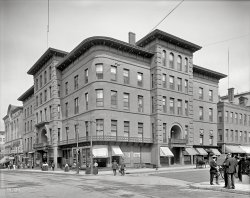
- 33 Center Street: 1910
- ... View full size.
Central Annex The Milner Hotel now occupies the spot where this building once stood. According to the ... Posted by Dave - 07/04/2011 - 2:16pm -
![33 Center Street: 1910 Detroit, Michigan, circa 1910. "No. 33 Center Street." Why this little house is in the Detroit Publishing archive is a mystery to me. Note yet another of those maypole-style telephone line drops. 8x10 glass negative. View full size.
Central AnnexThe Milner Hotel now occupies the spot where this building once stood. According to the 1910 Polk City Directory, the building at the right, 31 Center Street, was occupied by one Henry M. Catton. The building at the left was the Central Apartments at 35-41. 33 Center was the "Central Annex" and you can see that there is a connection between the Annex and the larger Central Apartments. Perhaps one of the residents of the Annex gained notoriety, prompting the photograph of their residence?
[My guess would be that whatever historical significance this place has lies back in the 19th century. A Google Books search shows that 33 Centre Street was headquarters of the Detroit Woman's Christian Association in 1890. There may have been some connection with the temperance movement. - Dave]
View Larger Map
PhotoworthyMaybe the entry to No. 33 is at the end of that narrow passageway and that is unusual enough to be both noteworthy and photoworthy.
CuriosityJust curious if the pole is actually an electric power drop.The insulators appear to be quite large. This area is in the general area where Edison Electric Illuminating was supplying DC power in the very early part of the 1900's.
I want my Maypole!That's a telephone drop. Single-wire conductors with a ground return. Power lines would be two conductors widely separated.
One more detailAnd a tip of the Hatlo Hat to the Old Hitching Post.
Damn ShuttersI can hear them banging all night long!
[Try leaving Mr. Shutter a note. - Dave]
Amazing, I'm thereI can actually see the Milner and Center street from my window at work right now. No sign of this house.
Thanks for the time-travel-moment, Shorpy.
The paversLook to be wood, probably soaked in creosote.
Window treatmentI like the way that the pediment over the window of the house next door matches the one over the door. Obviously the houses have come down in the world.
Re: I want my Maypole!Actually telephone lines are symmetrical, so they always are a pair of conductors.
[A lot of early systems used a single conductor with ground return. - Dave]
(The Gallery, Detroit Photos, DPC)](https://www.shorpy.com/files/images/4a20588a.thumbnail.jpg)























